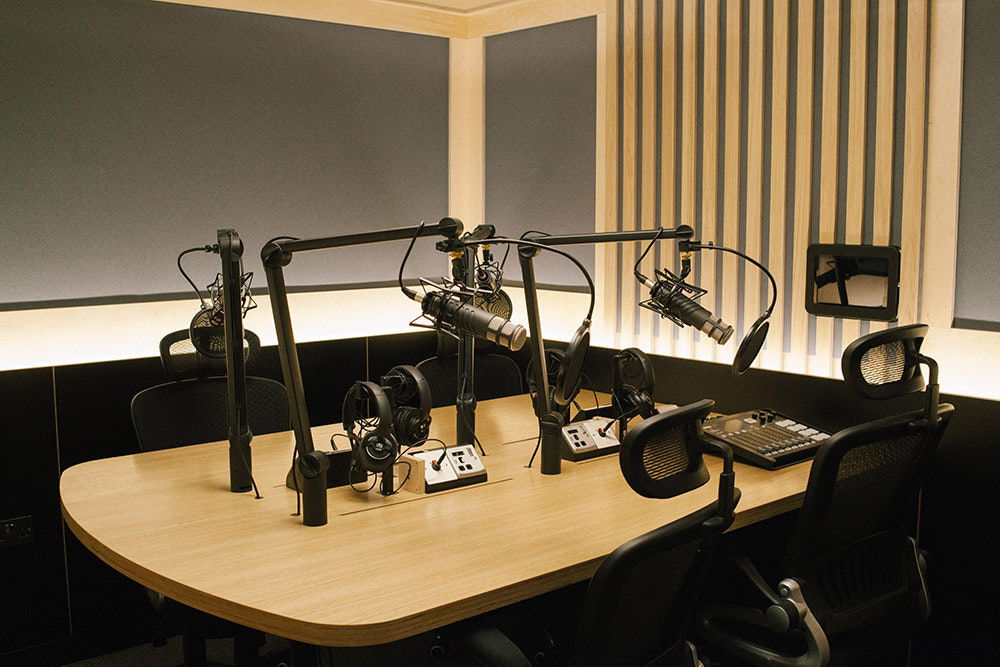
As the Managing Partner of GenX Capital Partners, I am always on the lookout for creative ways to breathe new life into underperforming assets, and office buildings are no exception. With the shift in work dynamics, we’re seeing more empty offices, but that doesn’t mean the buildings have to stay empty. One concept that’s been on my radar lately is converting these traditional office spaces into podcast, recording, and broadcasting studios. Here’s why this is such an interesting opportunity and how it’s being done successfully.
Why Podcast Studios? Podcasting is booming—there’s no doubt about it. The industry’s growth over the past few years has been phenomenal, and it’s showing no signs of slowing down. With millions of people listening to podcasts daily, there’s a huge demand for professional-quality recording spaces. This makes for a perfect tenant mix in a reimagined office building. By converting an office building into a podcast and recording studio hub, we can tap into a diverse pool of potential tenants. We’re not just talking about podcasters—this could also include radio stations, musicians, voice-over artists, and even content creators for YouTube and TikTok. The key is to create an environment that caters to these groups with top-of-the-line facilities, flexible leasing options, and shared resources.
What Does a Studio Conversion Look Like? First off, you have to rethink the floor plan. Soundproofing is essential, so converting standard office rooms into soundproofed studios is step one. Depending on the size of the building, you can create a variety of room sizes—from small booths perfect for one or two-person podcasts to larger spaces that can accommodate live bands or panel discussions. Add in a few control rooms and editing suites equipped with industry-standard software and equipment, and you’ve got a serious setup. And don’t forget the green rooms and lounge areas where talent and guests can relax and prep before going on air. But it’s not just about the studios themselves. You need shared equipment and amenities—high-end microphones, soundboards, cameras, and even post-production services that tenants can use without having to invest in it all upfront. This not only reduces the barrier to entry for smaller creators but also attracts bigger players looking for professional setups.
Revenue Models and Leasing Strategies When it comes to leasing, you can get really creative. Offer hourly rentals for the studios—this is perfect for podcasters who only need a few hours a week. Introduce a membership model for regular users, providing them with discounted rates and access to premium services. You can also structure full-service leases for larger tenants like radio stations or music labels who want dedicated studio space. Another option is to generate additional income through shared services fees—think audio and video editing, mixing, mastering, and more. By bundling these services into lease agreements, you’re offering more value and capturing additional revenue.
Successful Examples in the Market There are already some impressive conversions out there that show how effective this strategy can be. Take Spotify’s podcast production facility in Los Angeles. They built a dedicated studio space to streamline their in-house content creation and attract high-profile talent for exclusive podcasts. It’s become a hub for creativity and collaboration.
Or look at WeWork’s “Podcast Row” in New York City. By offering soundproofed studios, shared equipment, and flexible rental terms, they quickly filled up the space and created a buzz among content creators. And then there’s QCODE’s studio in Hollywood. They focused on creating a high-quality recording environment with immersive 3D audio capabilities, attracting everyone from independent creators to major production companies like Apple.
How We Can Apply This For us at GenX Capital Partners, a similar approach can turn an underutilized office building into a thriving media hub. We will start with a core group of anchor tenants—radio stations or digital media companies—and then build out smaller studios and shared spaces that cater to the growing demand from independent creators. Add in flexible leasing terms, revenue-sharing opportunities, and a marketing push to position the space as the go-to spot for content production, and we’ve got a winning formula. The long-term vision? Build a sense of community among tenants with networking events, workshops, and cross-promotion opportunities. Offer additional value with advanced technology setups and exclusive access to industry experts for content creation and strategy.
Anyway, this is going to be our approach for office moving forward, at least for the very near future.
Mark McClure
GenX Capital Partners
Mark@GenXCP.com